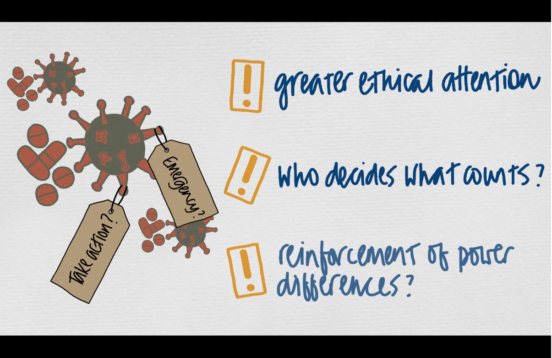The following series is supported by the Wellcome Trust and led by Dr Agomoni Ganguli Mitra. All animations were created by Vanessa Randle from thinkingvisually.
structural injustice in global health emergencies
In this animation, we discuss the concept of ‘Structural Injustice’. We look at what it is, how it’s different from other kinds of injustices, and why it’s important in the context of Global Health Emergencies.
The concept of structural injustice, as discussed in this animation is based on the work of philosopher Iris Marion Young.
For more see:
- Young (2011). Responsibility for Justice. Oxford; New York: Oxford University Press.
- Young (2006). Responsibility and Global Justice: A Social Connection Model. Social Philosophy and Policy, 23(1).
For full transcripts click here: Structural Injustice Animation Transcript.
Denaturalizing Natural disasters
In our second animation, Professor Matthew Hunt talks about how natural disasters and their impacts are not as ‘natural’ as they may first appear and how this should influence how we plan for, and respond to, such disasters.
For more, see:
- Chung, R., & Hunt, M. (2012). Justice and Health Inequalities in Humanitarian Crises: Structured Health Vulnerabilities and Natural Disasters. In P. T. Lenard (Ed.), Health Inequalities and Global Justice (pp. 197–212). Edinburgh University Press.
Download the full trancript: Denaturalizing Natural Disasters – Transcripts (PDF)
epistemic injustice
In our third animation, we discuss the concept of Epistemic Injustice and how this relates to Global Health Emergencies. In particular, we focus on the work of Miranda Fricker and discussion of Testimonial and Hermeneutical Injustice.
For more, see:
- Fricker, Epistemic Injustice: Power and the Ethics of Knowing (Oxford University Press, 2007)
- Kidd, Medina & Pohlhaus (eds), The Routledge Handbook of Epistemic Injustice (Taylor and Francis, 2017)
- Chung & Hunt (2019), ‘Epistemic Injustice and Humanitarian Action: The case of language and translation.’
- Eckenweiler (2019), ‘Seeking Asylum: Epistemic Injustice and Humanitarian Testimonies.’
- Scully (2019), ‘Responding to disability in Global Health Emergencies.’
nature of emergencies
We are currently living through a world wide global health emergency: the Covid-19 pandemic. Labelling a health event an emergency, disaster, or crisis imply an event that is confined to a certain time span and geographical focus. It is an extraordinary event that requires special measures. These terms in themselves are therefore worth questioning using the lenses of ethics and justice.
In our fourth animation, Agomoni Ganguli-Mitra discusses these terms and their ethical implications.
View the animation and full transcripts
For more, see:
- A. Green, ‘The activists trying to ‘decolonize’ global health‘, (devex, 21 May 2019).
- S. Walsh and O. Johnson, Getting to Zero: A Doctor and a Diplomat on the Ebola Frontline (Zed Books, 2018).
- A. Ahmad and others, Humanitarian Ethics Action and Ethics (Zed Books, 2018).
- S. Bradshaw, Gender, Development and Disasters (Edward Elgar Publishing, 2014).
Download the full transcript: Transcript – Nature of Emergencies Animation
This animation series was originally published by Justice in Global Health Emergencies & Humanitarian Crises: https://www.ghe.law.ed.ac.uk/animations/










Comments by Ritti Soncco